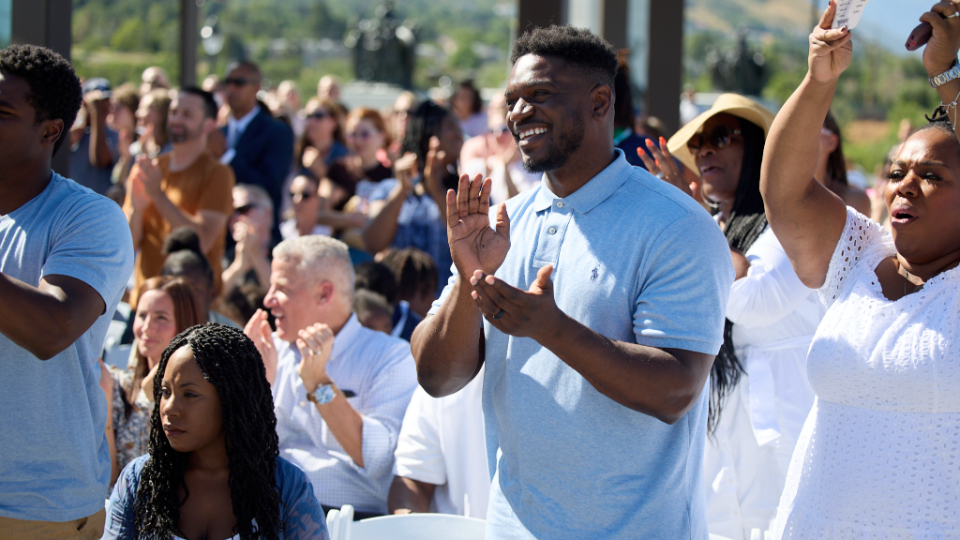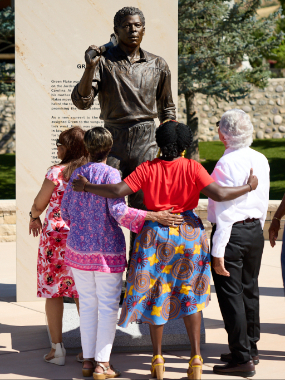The Acting President of the Quorum of the Twelve Apostles of The Church of Jesus Christ of Latter-day Saints has dedicated a new monument in Utah to four Black Latter-day Saint pioneers.
“We’re honored to be able to dedicate this memorial and these wonderful features that have now been added to declare to all who visit [This Is The Place Heritage Park] how precious and important every child of God is unto Thee,” President M. Russell Ballard said in his dedicatory prayer before several hundred people on Friday, July 22, 2022. “We are grateful for the Black pioneers and our dear friends of the Black community and in the Church and all that they do to bless the lives of others.”
Downloadable SOTs (Español)
-
- 20220722_105941_CBell_CMB_6813.jpg
- 20220722_102142_CBell_CMB_2725.jpg
- 20220722_105745_CBell_CMB_6610.jpg
- 20220722_105114_CBell_CMB_5668.jpg
- 20220722_104327_CBell_CMB_5039.jpg
- 20220722_103626_CBell_CMB_4586.jpg
- 20220722_103129_CBell_CMB_4230.jpg
- 20220722_102109_CBell_CMB_2354.jpg
- 20220722_102341_CBell_CMB_3133.jpg
- 20220722_101509_CBell_CMB_1745.jpg
- 20220722_102228_CBell_CMB_2991.jpg
- 20220722_110451_CBell_CMB_7236.jpg
- 20220722_115425_CBell_CMB_34721.jpg
- Green-Flake-2.png
- JaneManning1.jpeg
- Jane-Manning1.png
| Temple Square is always beautiful in the springtime. Gardeners work to prepare the ground for General Conference. © 2012 Intellectual Reserve, Inc. All rights reserved. | 1 / 2 |
President Ballard’s remarks came two days before the 175th anniversary of the arrival of the state’s first pioneers in July 1847. Three of those featured at the monument — Green Flake and his brothers-in-law, Hark Wales and Oscar Smith — were in the vanguard group of pioneers who arrived in the Salt Lake Valley on July 22, 1847. The fourth, Jane Elizabeth Manning James, came in September 1847.
“Protect these wonderful representations [that] remind us of who we are and what blessings we enjoy because of those pioneers, our forefathers, who have come before us and made it possible for us to have all of these wonderful blessings today,” President Ballard prayed.
Three statues and three 10-foot-high stone slabs (one foot for each of the 10 years of legalized slavery in Utah between 1852 and 1862) represent the contributions of all Black pioneers in the settling of Utah and are intended to create a place of learning, reflection and healing. The monument was designed by Stefanie and Roger Hunt of Hunt Sculpture Studio and cast in bronze by Metal Arts Foundry. The stories of these pioneers were engraved in stone from the Brown’s Canyon quarry in Utah.

20220722_102341_CBell_CMB_3133.jpg
People gather at This Is The Place Heritage Park in Salt Lake City on Friday, July 22, 2022, for the dedication of a new monument to Black pioneers in Utah. 2022 by Intellectual Reserve, Inc. All rights reserved.Utah Governor Spencer Cox was one of Friday’s featured speakers. He said learning pioneer stories helped him endure his difficult teenage years.
“I realized that [my pioneer ancestors] did hard things and that I was somebody, that I came from somewhere, from some people that did some really important things in the state. And that changed my whole outlook,” Governor Cox said. “And I want that for everyone. For far too long, there have been people in [Utah] that have not had that.”
Everyone can find strength in the stories of Black pioneers, the governor added.
“We must learn from each other,” he said. “I look at [the faces of these statues]. There is strength in these faces. There is pride in these faces. And yet there’s humility and kindness in these faces. … We’re here to celebrate a certain group of pioneers that have long been forgotten.”

20220722_102142_CBell_CMB_2725.jpg
Descendants of Green Flake take a moment to admire a new statue of their ancestor at This Is The Place Heritage Park in Salt Lake City on Friday, July 22, 2022.2022 by Intellectual Reserve, Inc. All rights reserved.Green Flake was born into slavery on January 6, 1828, in North Carolina. At age 10, he was given to James and Agnes Flake. They moved to Mississippi. At age 19, Flake drove the first wagon of pioneers into Emigration Canyon under the direction of Orson Pratt.
Jane Elizabeth Manning James was born free in Wilton, Connecticut, around 1822. After an arduous journey to Nauvoo by foot — she was denied boat passage because of her race — she lived for a time with Joseph Smith’s family. She was expecting her third child when she entered the Salt Lake Valley in September 1847. She remained a faithful and respected Latter-day Saint until her death in 1908.
Hark Wales and Oscar Smith were brothers, born into bondage on a plantation in Mississippi. Latter-day Saint pioneer John Brown, the overseer who managed their enslaved labor, took them to Council Bluffs, Iowa, where they were chosen to be part of Brigham Young’s vanguard company.
“In this moment, at this place, we are who we hope to be,” said Mauli Junior Bonner, the monument’s coordinator. “Distance from these stories is not a remedy. We must journey through the hard parts together. To our Black pioneer ancestors, we bring our peace, our reverence, our joy, our empathy, our shouts of celebration, our love and our unity to this monument. As we look around this park and we see many who settled in this territory, we can now include our free and enslaved Black pioneers. This first group of pioneers in 1847 will never be forgotten. Their memory will live on for generations here at This Is The Place Heritage Park.”